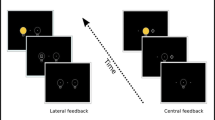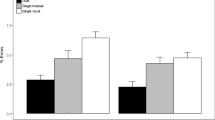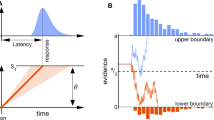Abstract
The present paper presents an overview of research on the role of saccades in multitasking. Multitasking is known to cause performance costs in terms of increased response times and/or error rates. However, most of the previous research on multitasking was focused on manual and vocal action demands, and the role of eye movements has been largely neglected. As a consequence, saccade execution was mainly considered with respect to its functional role in gathering new visual information (input side of information processing). However, several more recent experiments confirmed that saccades both exhibit and cause dual-task costs in the context of other actions and should thus also be regarded as a response modality (output side of information processing). Theoretical implications as well as several open issues for future research will be outlined.

Similar content being viewed by others
References
Allport, D. A. (1980). Attention and performance. In G. L. Claxton (Ed.), Cognitive psychology: new directions (pp. 112–153). London: Routledge.
Allport, A., Styles, E. A., & Hsieh, S. (1994). Shifting intentional set: exploring the dynamic control of tasks. In C. Umilta & M. Moscovitch (Eds.), Attention and performance XV (pp. 421–452). Cambridge: MIT Press.
Baker, J. T., Donoghue, J. P., & Sanes, J. N. (1999). Gaze direction modulates finger movement activation patterns in human cerebral cortex. Journal of Neuroscience, 19, 10044–10052.
Battaglia-Mayer, A., Archambault, P. S., & Caminiti, R. (2006). The cortical network for eye-hand coordination and its relevance to understanding motor disorders of parietal patients. Neuropsychologia, 44, 2607–2620.
Battaglia-Mayer, A., Ferraina, S., Mitsuda, T., Marconi, B., Genovesio, A., Onorati, P., et al. (2000). Early coding of reaching in the parietooccipital cortex. Journal of Neurophysiology, 83, 2374–2391.
Bekkering, H., Adam, J. J., Kingma, H., Huson, A., & Whiting, H. T. A. (1994). Reaction time latencies of eye and hand movements in single- and dual-task conditions. Experimental Brain Research, 97, 471–476.
Bekkering, H., Adam, J. J., van den Aarssen, A., Kingma, H., & Whiting, H. T. (1995). Interference between saccadic eye and goal-directed hand movements. Experimental Brain Research, 106, 475–484.
Bekkering, H., & Sailer, U. (2002). Commentary: coordination of eye and hand in time and space. Progress in Brain Research, 140, 365–373.
Boot, W. R., Kramer, A. F., Becic, E., Wiegmann, D. A., & Kubose, T. (2006). Detecting transient changes in dynamic displays: the more you look, the less you see. Human Factors, 48, 759–773.
Botvinick, M., Braver, T., Barch, D., Carter, C., & Cohen, J. (2001). Conflict monitoring and cognitive control. Psychological Review, 108, 624–652.
Broadbent, D. E. (1982). Task combination and selective intake of information. Acta Psychologica, 50, 253–290.
Brown, S. H., Kessler, K. R., Hefter, H., Cooke, J. D., & Freund, H.-J. (1993). Role of the cerebellum in visuomotor coordination. Experimental Brain Research, 94, 478–488.
Buetti, S., & Kerzel, D. (2010). Effects of saccades and response type on the Simon effect: if you look at the stimulus, the Simon effect may be gone. The Quarterly Journal of Experimental Psychology, 63, 2172–2189.
Buneo, C. A., Jarvis, M. R., Batista, A. P., & Andersen, R. A. (2002). Direct visuomotor transformations for reaching. Nature, 416, 632–636.
Byrne, M. D., & Anderson, J. R. (2001). Serial modules in parallel: the psychological refractory period and perfect time-sharing. Psychological Review, 108, 847–869.
Carbone, E., & Schneider, W. X. (2010). The control of stimulus-driven saccades is subject not to central, but to visual attention limitations. Attention, Perception, and Psychophysics, 72, 2168–2175.
Carey, D. P. (2000). Eye-hand coordination: eye to hand or hand to eye? Current Biology, 10, 416–419.
Crawford, J. D., Medendorp, W. P., & Marotta, J. J. (2004). Spatial transformations for eye-hand coordination. Journal of Neurophysiology, 92, 10–19.
Dreisbach, G., Goschke, T., & Haider, H. (2006). Implicit task sets in task switching? Journal of Experimental Psychology Learning, Memory, and Cognition, 32, 1221–1233.
Epelboim, J., Steinman, R. M., Kowler, E., Pizlo, Z., Erkelens, C. J., & Collewijn, H. (1997). Gaze-shift dynamics in two kinds of sequential looking tasks. Vision Research, 37, 2597–2607.
Evens, D. R., & Ludwig, C. J. (2010). Dual-task costs and benefits in anti-saccade performance. Experimental Brain Research, 205, 545–557.
Fagot, C., & Pashler, H. (1992). Making two responses to a single object: implications for the central attentional bottleneck. Journal of Experimental Psychology Human Perception and Performance, 18, 1058–1079.
Findlay, J. M., & Gilchrist, I. D. (2003). Active vision: the psychology of looking and seeing. Oxford: Oxford University Press.
Hazeltine, E., Ruthruff, E., & Remington, R. W. (2006). The role of input and output modality pairings in dual-task performance: evidence for content-dependent central interference. Cognitive Psychology, 52, 291–345.
Henderson, J. M. (2005). Human gaze control during real-world scene perception. Trends in Cognitive Science, 7, 498–504.
Herman, L. M., & Kantowitz, B. H. (1970). The psychological refractory period effect: only half the double-stimulation story? Psychological Bulletin, 73, 74–88.
Hodgson, T. L., Müller, H. J., & O’Leary, M. J. (1999). Attentional localization prior to simple and directed manual responses. Perception & Psychophysics, 61, 308–321.
Hommel, B. (1998). Automatic stimulus-response translation in dual-task performance. Journal of Experimental Psychology Human Perception and Performance, 24, 1368–1384.
Horstmann, A., & Hoffmann, K. P. (2005). Target selection in eye-hand coordination: do we reach to where we look or do we look to where we reach? Experimental Brain Research, 167, 187–195.
Huestegge, L. (2010). Effects of vowel length on gaze durations in silent and oral reading. Journal of Eye Movement Research, 3(5):5, 1–18.
Huestegge, L., & Adam, J. J. (2011). Oculomotor interference during manual response preparation: evidence from the response cueing paradigm. Attention, Perception, and Psychophysics, 73, 702–707.
Huestegge, L., & Koch, I. (2009). Dual-task crosstalk between saccades and manual responses. Journal of Experimental Psychology Human Perception and Performance, 35, 352–362.
Huestegge, L., & Koch, I. (2010a). Crossmodal action selection: evidence from dual-task compatibility. Memory and Cognition, 38, 493–501.
Huestegge, L., & Koch, I. (2010b). Fixation disengagement enhances peripheral perceptual processing: evidence for a perceptual gap effect. Experimental Brain Research, 201, 631–640.
Huestegge, L., Radach, R., Corbic, D., & Huestegge, S. M. (2009). Oculomotor and linguistic determinants of reading development: a longitudinal study. Vision Research, 49, 2948–2959.
Huestegge, L., Skottke, E.-M., Anders, S., Debus, G., & Müsseler, J. (2010). The development of hazard perception: dissociation of visual orientation and hazard processing. Transportation Research, 13F, 1–8.
Irwin, D. E., & Thomas, L. E. (2007). The effect of saccades on number processing. Perception and Psychophysics, 69, 450–458.
Johansson, R. S., Westling, G., Backstrom, A., & Flanagan, J. R. (2001). Eye-hand coordination in object manipulation. The Journal of Neuroscience, 21, 6917–6932.
Jonikaitis, D. & Deubel, H. (2011). Parallel and independent allocation of attention to eye and hand movement goals. Psychological Science (in press).
Jonikaitis, D., Schubert, T., & Deubel, H. (2010). Preparing coordinated eye and hand movements: dual task costs are not attentional. Journal of Vision, 10(14), 1–17.
Just, M. A., & Carpenter, P. A. (1980). A theory of reading: from eye fixations to comprehension. Psychological Review, 87, 329–354.
Kahneman, D. (1973). Attention and effort. Englewood Cliffs: Prentice Hall.
Kiesel, A., Steinhauser, M., Wendt, M., Falkenstein, M., Jost, K., Philipp, A. M., et al. (2010). Control and interference in task switching––a review. Psychological Bulletin, 136, 849–874.
Kinsbourne, M. (1981). Single channel theory. In D. H. Holding (Ed.), Human skills (pp. 65–89). Chichester: Wiley.
Kliegl, R., Nuthmann, A., & Engbert, R. (2006). Tracking the mind during reading: the influence of past, present, and future words on fixation durations. Journal of Experimental Psychology General, 135, 12–35.
Koch, I. (2009). The role of crosstalk in dual-task performance: evidence from manipulating response-set overlap. Psychological Research, 73, 417–424.
Kunar, M. A., Carter, R., Cohen, M., & Horowitz, T. S. (2008). Telephone conversation impairs sustained visual attention via a central bottleneck. Psychonomic Bulletin and Review, 15, 1135–1140.
Land, M. F. (2005). Eye-hand coordination learning a new trick. Current Biology, 15, 955–956.
Land, M. F., & Hayhoe, M. M. (2001). In what ways do eye movements contribute to everyday activities? Vision Research, 41, 3559–3565.
Levy, J., & Pashler, H. (2001). Is dual-task slowing instruction dependent. Journal of Experimental Psychology Human Perception and Performance, 27, 862–869.
Levy, J., Pashler, H., & Boer, E. (2006). Central interference in driving: is there any stopping the psychological refractory period? Psychological Science, 17, 228–235.
Logan, G. D., & Gordon, R. D. (2001). Executive control of visual attention in dual-task situations. Psychological Review, 108, 393–434.
Lünenburger, L., Kutz, D. F., & Hoffmann, K. P. (2000). Influence of arm movements on saccades in humans. European Journal of Neuroscience, 12, 4107–4116.
Malmstrom, F. V., Reed, L. E., & Weber, R. J. (1983). Saccadic eye movements during a concurrent auditory task. Bulletin of the Psychonomic Society, 27, 31–34.
Marois, R., & Ivanoff, J. (2005). Capacity limits of information processing in the brain. Trends in Cognitive Sciences, 9, 296–304.
Mather, J., & Fisk, J. (1985). Orienting to targets by looking and pointing: parallels and interactions in ocular and manual performance. Quarterly Journal of Experimental Psychology, 37A, 315–338.
Mather, J. A., & Lackner, J. R. (1980). Visual tracking of active and passive movements of the hand. Quarterly Journal of Experimental Psychology, 32, 307–315.
Mather, J. A., & Putchat, C. (1983). Parallel ocular and manual tracking responses to a continuously moving visual target. Journal of Motor Behavior, 15, 29–38.
McLeod, P., & Posner, M. I. (1984). Privileged loops from percept to act. In H. Bouma & D. G. Bouwhuis (Eds.), Attention and Performance X. Control of language processes (pp. 55–66), Hove, UK: Lawrence Erlbaum Associates.
Megaw, E. D., & Armstrong, W. (1973). Individual and simultaneous tracking of a step input by the horizontal saccadic eye movement and manual control systems. Journal of Experimental Psychology, 100, 18–28.
Meyer, D. E., & Kieras, D. W. (1997). A computational theory of executive cognitive processes and multiple-task performance: Part 1. Basic mechanisms. Psychological Review, 104, 3–65.
Miller, J. (1982). Discrete versus continuous models of human information processing: in search of partial output. Journal of Experimental Psychology Human Perception and Performance, 8, 273–296.
Müsseler, J., Aschersleben, G., Arning, K., & Proctor, R. (2009). Reversed effects of spatial compatibility in natural scenes. American Journal of Psychology, 122, 325–336.
Navon, D. (1984). Resources––A theoretical soupstone? Psychological Review, 91, 216–234.
Navon, D. (1985). Attention division or attention sharing. In M. I. Posner & O. S. M. Marin (Eds.), Attention and performance XI (pp. 133–146). Hillsdale, NJ: Erlbaum.
Navon, D., & Gopher, D. (1979). On the economy of the human information processing system. Psychological Review, 86, 214–255.
Navon, D., & Miller, J. (1987). Role of outcome conflict in dual-task interference. Journal of Experimental Psychology Human Perception and Performance, 13, 435–448.
Navon, D., & Miller, J. (2002). Queuing or sharing. A critical evaluation of the single-bottleneck notion. Cognitive Psychology, 44, 193–251.
Neumann, O. (1987). Beyond capacity: a functional view of attention. In H. Heuer & A. F. Sanders (Eds.), Perspectives on perception and action (pp. 361–394). Hillsdale: Erlbaum.
Niechwiej-Szwedo, E., McIlroy, W. E., Green, R. E. A., & Verrier, M. C. (2005). The effect of directional compatibility on the response latencies of ocular and manual movements. Experimental Brain Research, 162, 220–229.
Nitschke, M. F., Arp, T., Stavrou, G., Erdmann, C., & Heide, W. (2005). The cerebellum in the cerebro-cerebellar network fort he control of eye and hand movements––an fMRI study. Progress in Brain Research, 148, 151–164.
Norman, D. A., & Bobrow, D. G. (1975). On data limited and resource limited processes. Cognitive Psychology, 7, 44–64.
Pashler, H. (1994). Dual-task interference in simple tasks: data and theory. Psychological Bulletin, 116, 220–244.
Pashler, H. (1998). The psychology of attention. Cambridge: MIT Press.
Pashler, H., Carrier, M., & Hoffman, J. (1993). Saccadic eye movements and dual-task interference. Quarterly Journal of Experimental Psychology, 46A, 51–82.
Pelz, J., Hayhoe, M. M., & Loeber, R. (2001). The coordination of eye, head, and hand movements in a natural task. Experimental Brain Research, 139, 266–277.
Posner, M. I. (1980). Orienting of attention. Quarterly Journal of Experimental Psychology, 32, 3–25.
Posner, M. I., Nissen, M. J., & Ogden, W. C. (1978). Attended and unattended processing modes: the role of set for spatial location. In H. L. Pick Jr. & I. J. Saltzman (Eds.), Modes of perceiving and processing information (pp. 137–157). Hillsdale: Erlbaum.
Prablanc, C., Echallier, J. E., Jeannerod, M., & Komilis, E. (1979a). Optimal response of eye and hand motor systems in pointing at a visual target. II. Static and dynamic visual cues in the control of hand movement. Biological Cybernetics, 35, 183–187.
Prablanc, C., Echallier, J. F., Komilis, E., & Jeannerod, M. (1979b). Optimal response of eye and hand motor systems in pointing at a visual target. I. Spatio-temporal characteristics of eye and hand movements and their relationships when varying the amount of visual information. Biological Cybernetics, 35, 113–124.
Pratt, J., Bekkering, H., Abrams, R. A., & Adam, J. (1999). The gap effect for spatially oriented responses. Acta Psychologica, 102, 1–12.
Ramnani, N., Toni, I., Passingham, R. E., & Haggard, P. (2001). The cerebellum and parietal cortex play a specific role in coordination: a PET study. NeuroImage, 14, 899–911.
Rayner, K. (1998). Eye movements in reading and information processing: 20 years of research. Psychological Bulletin, 124, 372–422.
Rayner, K. (2009). Eye movements and attention in reading, scene perception, and visual search. Quarterly Journal of Experimental Psychology, 62, 1457–1506.
Rizzolatti, G., Riggio, L., Dascola, I., & Umilta, C. (1987). Reorienting attention across the horizontal and vertical meridians: evidence in favor of a premotor theory of attention. Neuropsychologia, 25, 31–40.
Roberts, R. J., Hager, L. D., & Heron, C. (1994). Prefrontal cognitive processes: working memory and inhibition in the antisaccade task. Journal of Experimental Psychology General, 123, 374–393.
Rogers, R. D., & Monsell, S. (1995). The cost of a predictable switch between simple cognitive tasks. Journal of Experimental Psychology General, 124, 207–231.
Ruthruff, E., Hazeltine, E., & Remington, R. W. (2005). What causes residual dual-task interference after practice? Psychological Research, 70, 494–503.
Salvucci, D. D., & Taatgen, N. A. (2008). Threaded cognition: an integrated theory of concurrent multitasking. Psychological Review, 115, 101–130.
Saslow, M. G. (1967). Effects of components of displacement-step stimuli upon latency for saccadic eye movement. Journal of the Optical Society of America, 57, 1024–1029.
Schneider, W. X., & Deubel, H. (2002). Selection-for-perception and selection-for-spatial-motor-action are coupled by visual attention: a review of recent findings and new evidence from stimulus-driven saccade control. In W. Prinz & B. Hommel (Eds.), Attention and performance XIX: common mechanisms in perception and action (pp. 609–627). Oxford: Oxford University Press.
Shaffer, L. H. (1975). Multiple attention in continuous verbal tasks. In P. M. A. Rabbitt & S. Dornic (Eds.), Attention and performance V (pp. 157–167). New York: Academic Press.
Sharikadze, M., Cong, D. K., Staude, G., Deubel, H., & Wolf, W. (2009). Dual-tasking: is manual tapping independent of concurrently executed saccades? Brain Research, 1283, 41–49.
Simon, J. R. (1969). Reactions toward the source of stimulation. Journal of Experimental Psychology, 81, 174–176.
Snyder, L. H., Batista, A. P., & Andersen, R. A. (2000). Saccade-related activity in the parietal reach region. Journal of Neurophysiology, 83, 1099–1102.
Snyder, L. H., Calton, J. L., Dickinson, A. R., & Lawrence, B. M. (2002). Eye-hand coordination: saccades are faster when accompanied by a coordinated arm movement. Journal of Neurophysiology, 87, 2279–2286.
Solomons, L. M., & Stein, G. (1896). Normal motor automatism. Psychological Review, 3, 492–512.
Spelke, E. S., Hirst, W., & Neisser, U. (1976). Skills of divided attention. Cognition, 4, 215–230.
Steinbach, M. J., & Held, R. (1968). Eye tracking of observer-generated target movements. Science, 161, 187–188.
Stelzel, C., Schumacher, E., Schubert, T., & D’Esposito, M. (2006). The neural effect of stimulus-response modality compatibility on dual-task performance: an fMRI study. Psychological Research, 70, 514–525.
Stephan, D. N., & Koch, I. (2010). Central crosstalk in task switching: Evidence from manipulating input-output modality compatibility. Journal of Experimental Psychology Learning, Memory, and Cognition, 36, 1075–1081.
Strayer, D., Drews, F., & Johnston, W. (2003). Cell-phone induced failures of visual attention during simulated driving. Journal of Experimental Psychology Applied, 9, 23–32.
Stuyven, E., Van der Goten, K., Vandierendonck, A., Claeys, K., & Crevits, L. (2000). The effect of cognitive load on saccadic eye movements. Acta Psychologica, 104, 69–85.
Styles, E. A. (1997). The psychology of attention. Hove: Psychology Press.
Tibber, M. S., Grant, S., & Morgan, M. J. (2009). Oculomotor responses and visuospatial perceptual judgments compete for common limited resources. Journal of Vision, 9, 1–13.
Tombu, M., & Jolicoeur, P. (2003). A central capacity sharing model of dual-task performance. Journal of Experimental Psychology Human Perception and Performance, 29, 3–18.
Vandierendonck, A., Deschuyteneer, M., Depoorter, A., & Drieghe, D. (2008). Input monitoring and response selection as components of executive control in pro-saccades and anti-saccades. Psychological Research, 72, 1–11.
Vidoni, E. D., McCarley, J. S., Edwards, J. D., & Boyd, L. A. (2009). Manual and oculomotor performance develop contemporaneously but independently during continuous tracking. Experimental Brain Research, 195, 611–620.
Ward, A. (2004). Attention: a neuropsychological approach. New York: Psychology Press.
Welford, A. T. (1952). The “psychological refractory period” and the timing of high-speed performance––a review and a theory. British Journal of Psychology, 434, 2–19.
Wickens, C. D. (1980). The structure of attentional resources. In R. Nickerson (Ed.), Attention and performance VIII (pp. 239–257). Hillsdale: Erlbaum.
Wickens, C. D. (1984). Processing resources in attention. In R. Parasuraman & D. R. Davies (Eds.), Varieties of attention (pp. 63–102). Orlando: Academic Press.
Wickens, C. D. (2002). Multiple resources and performance prediction. Theoretical Issues in Ergonomics Science, 3, 159–177.
Wright, R. D., & Ward, L. M. (2008). Orienting of Attention. New York: Oxford University Press.
Author information
Authors and Affiliations
Corresponding author
Rights and permissions
About this article
Cite this article
Huestegge, L. The role of saccades in multitasking: towards an output-related view of eye movements. Psychological Research 75, 452–465 (2011). https://doi.org/10.1007/s00426-011-0352-5
Received:
Accepted:
Published:
Issue Date:
DOI: https://doi.org/10.1007/s00426-011-0352-5




